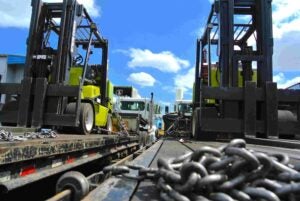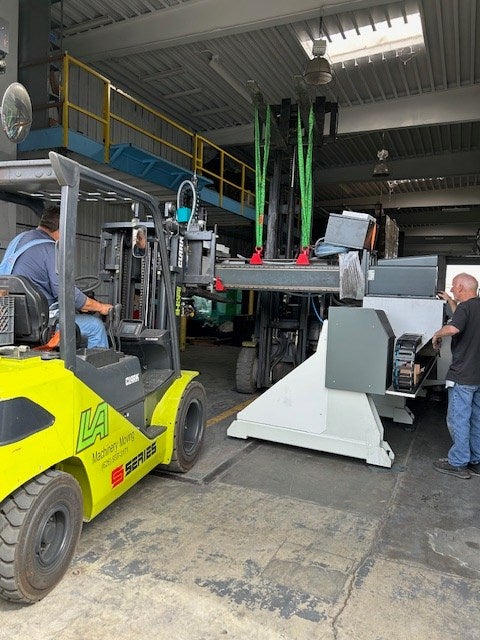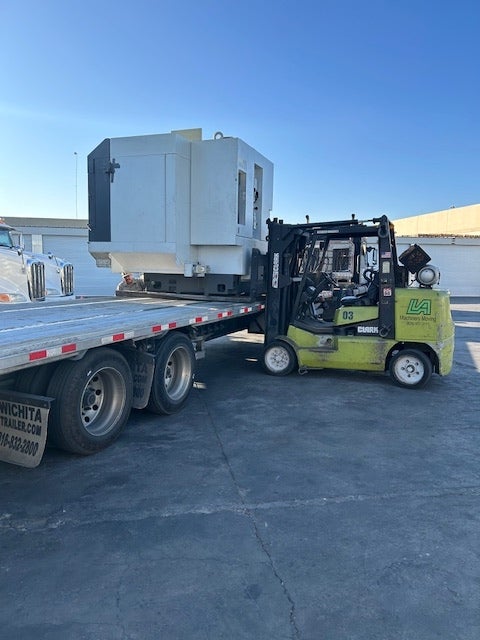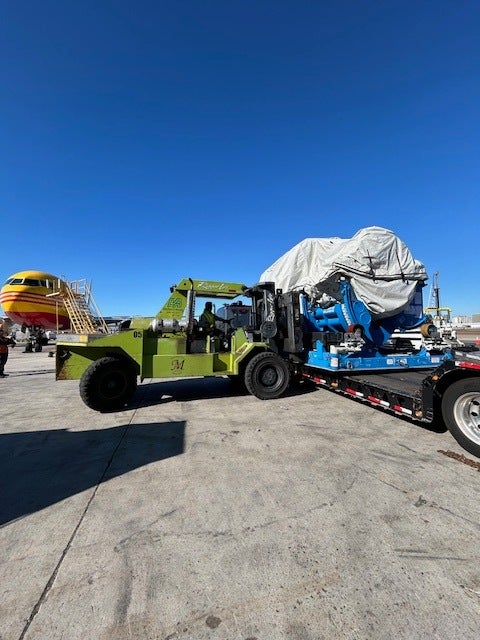-
Guide for Forklift Transportation and Moving
Your Comprehensive Guide to Forklift Transportation & Moving
Moving a forklift isn’t something most businesses tackle every day, but when it’s time, doing it right matters. Forklifts are powerful machines built to handle heavy loads, but getting one safely from point A to point B requires a thoughtful approach and the right expertise.
Professional forklift transport ensures your equipment arrives safely and stays in peak condition, whether you’re relocating it across town, over state lines, or halfway around the globe. Our comprehensive guide will walk you through everything you need to know to seamlessly move and relocate this heavy yet essential commercial piece of equipment.

When Do You Need Forklift Transportation Services?
Moving industrial equipment like forklifts can be trickier than it seems. So, when should you call in the pros? Whether you’re planning to streamline your operations, upgrade your facility, or just need to move your equipment over a long distance, it’s smart to rely on professionals who specialize in forklift transport services. A heavy equipment moving company like LA Machinery Moving knows exactly how to handle the logistics safely and efficiently, ultimately saving you time, effort, and the risk of potentially damaging your machinery.
Partnering with forklift transportation experts means your equipment will arrive at its destination ready for action without the headaches – and substantial safety hazards – of figuring it out on your own.
Key Considerations Before Transporting a Forklift
Transporting a forklift to a new location isn’t as simple as loading it up and driving away. Moving heavy equipment is a multifaceted process that demands thoughtful planning and serious attention to detail. Overlook one small factor, and things can quickly spiral into unmanageable chaos. That’s why it’s critical to know what needs to be considered and accounted for before relocating a forklift.
- Forklift Specifications – Knowing your forklift’s exact dimensions, weight, and type is essential for a smooth move. The transport equipment used to move the forklift must align with these specifications, and movers with forklift expertise will rely on this data to ensure the process is seamless and safe.
- Regulations and Permits – Transporting forklifts often involves adhering to local, state, and federal regulations. Depending on the route and machinery size, special permits may be required. Heavy equipment moving professionals ensure no critical legislative details are missed during the process.
- Safety Precautions – Moving heavy machinery inevitably comes with risks. Properly trained personnel must oversee the loading process, with safety equipment like personal protective gear and wheel blocks securely in place. Avoiding accidents starts by preparing meticulously and prioritizing everyone’s safety.
- Transport Vehicle and Equipment – The type of flatbed trailer or truck matters. There must be no question about the vehicle’s ability to bear the forklift’s weight. Loading these machines requires the right ramps, tie-downs, and securement tools to keep everything steady during the trip.
- Route Planning and Timing – The transit route should be planned for efficiency and thoughtfully pre-determined to steer clear of tight corners, weight restrictions, and narrow roadways. Heavy equipment moving companies account for anticipated travel times to avoid potential delays or logistical complications.
Transport Methods for Forklifts
There are several ways to transport forklifts, but which one works best for hauling your machinery? Depending on the size, weight, and route distance, here are four commonly used options:
Flatbed Truck
A flatbed truck offers substantial space and a high weight capacity, making it suitable for transporting one or more forklifts. It features a low deck for easy loading and avoids clearance issues on the road. This truck type is particularly useful for long-distance transportation.
Tow Trailer
A tow trailer is a cost-efficient option for transporting forklifts over short to medium distances, but it must have sufficient weight capacity to hold the forklift. Once verified, the forklift can be driven onto the trailer and firmly secured with straps or chains to prevent movement during transit.
Tilt Tray Truck
Due to its tilt tray bed, a tilt tray truck makes loading and unloading forklifts smooth and straightforward. This type of transport is excellent for managing multiple forklifts at the same time, depending on size, and can easily handle medium-haul distances.
Automated Tailgate
An automated tailgate provides the largest capacity of all options, making it ideal for transporting heavy-duty or multiple forklifts. This method keeps everything safe and stable by allowing for more controlled loading and unloading, particularly for large-scale operations that demand absolute precision.
Getting a Forklift Transport-Ready
Getting a forklift ready for transport requires a careful preparation process and safety precautions along the way:
- Determine the Forklift’s Weight and Dimensions – Calculate the weight and measurements of the forklift to confirm compatibility with your trailer or transport vehicle. This step prevents mismatches and ensures a solid foundation for safe transport.
- Inspect the Forklift for Functionality and Safety – Conduct a thorough inspection of the forklift to confirm it is fully operational. Secure wheel chocks to stabilize the forklift and avoid any potential movement during loading.
- Lower and Position the Forks Properly – Lower the forks to the floor and tilt them to a slight forward angle. This positioning improves stability and prevents any unexpected shifts during transit.
- Secure the Forklift on the Trailer – Use blocks or wedges behind each wheel and secure them with fasteners to the trailer’s flooring. This action locks the forklift in place, adding another layer of safety.
- Power Down and Prepare Fuel Systems – Shut off the fuel supply by disconnecting the propane tank or tightening the fuel cap for gasoline or diesel models. Disconnect the battery terminal to avoid electrical issues during transport.
- Fasten With Chains and Tie-Downs – Attach chains or come-alongs to the truck’s anchor points, ensuring all connections are tight and secure. This step prevents movement and keeps the forklift in place while on the road.
Common Forklift Moving Challenges and How to Avoid Them
Transporting forklifts comes with its own set of challenges, starting with the fact that specialized shipping for forklifts isn’t in high demand. This often makes it difficult to find carriers, ultimately driving up both the cost and availability. Fewer specialized carriers mean higher prices, especially when flatbed trucks are required for the job. Planning and researching available services can help you avoid last-minute headaches and keep shipping costs manageable.
Another common obstacle involves the sheer size and weight of forklifts, which require careful consideration for loading and unloading. To ensure everything runs smoothly, it’s important to utilize proper equipment like ramps or cranes to simplify the process. Preparing ahead for each stage of transport minimizes delays and ensures forklifts are handled with care at every step.
Choosing the Right Forklift Transport Partner
Taking all the above into account can feel overwhelming without proper experience – a single overlooked detail can throw the entire operation off course. That’s why partnering with skilled movers with heavy machinery moving experience makes all the difference, saving you time, energy, and unnecessary headaches. Whether it’s speed and cost or security and peace of mind, the right method for completing your forklift transport project ultimately depends on your top priorities. Here are some of the main factors to weigh as you decide:
- Look at their experience with transporting heavy machinery, especially forklifts.
- Confirm they have the equipment necessary for safe handling, including specialized trailers and loading tools like ramps.
- Make sure they have the proper licenses and insurance to safeguard your shipment.
- Check their reputation and track record for safety by reviewing customer feedback.
- Discuss transit times and delivery options to ensure your schedule aligns with their services.
Make Forklift Transport Stress-Free With LA Machinery Moving
Moving a forklift doesn’t have to be complicated. At LA Machinery Moving, we specialize in full-service forklift transport solutions across the Greater Los Angeles area and beyond. If you need your forklift moved from one location to another, our team will provide a comprehensive plan of action, complete the project, and keep your assets safe. Whether moving your equipment across town or around the globe, request your free estimate today and see why we’re the renowned heavy equipment moving company you can trust from start to finish.
-
Guide for Moving Heavy Equipment & Machinery
Moving heavy equipment and machinery is a complex and critical task for many industrial businesses, requiring precision, expertise, and a thorough plan for success. Relocating factory machinery, industrial equipment, or other sizable assets in Los Angeles, is no small task due to the weight, dimensions, and transportation challenges involved. However, proper planning, the right tools, and experienced heavy equipment movers can make all the difference.

Why Moving Heavy Equipment Requires Expertise
Transporting heavy machinery is a real challenge—it demands significant preparation to mitigate safety risks, prevent damage, and comply with regulatory standards. Mishandling machinery or relying on inexperienced movers can result in accidents, financial losses, or lengthy project delays. Partnering with seasoned heavy equipment movers, like LA Machinery Moving, guarantees operations proceed efficiently and that your costly equipment is relocated safely.
Pre-Move Planning
Understand the Scope of the Job
Before moving, assess the machinery’s dimensions, weight, and the specifics required for its disassembly, if applicable. Consider potential challenges such as tight spaces, irregular terrain, or delicate components. Identifying such details early helps you plan a seamless move.
Create a Comprehensive Moving Plan
Preparation is everything. Outline a moving timeline, define roles and responsibilities, and confirm transportation methods that account for the equipment’s size and weight. If permits are necessary for oversized equipment, check that they are secured in advance to prevent delays.
Partner with Experts
For large-scale or technically complex tasks, hiring professional industrial machinery movers is key. Look for a company with decades of experience, like LA Machinery Moving, for client-centric services and security.
Safety Measures and Best Practices
Safety should always be paramount during a heavy equipment move. Below are some of the key measures and practices to follow:
- Perform Risk Assessments: Identify hazards, such as electrical disconnections, fluid leakages, or improperly secured components.
- Use Proper Lifting Techniques: Safety inspections and appropriate safety gear are essential to prevent workplace injuries.
- Communicate Clearly: All personnel involved should be briefed on the process. Use clear hand signals or proper communication tools during the operation.
When in doubt, turning to experienced professionals for a higher level of safety and oversight throughout the moving process.
Tools and Equipment for Moving Heavy Machinery
Using the right tools is paramount for transporting heavy machinery securely and effectively.
Essential Tools
The following are indispensable when relocating equipment:
- Heavy-duty machinery skates for smooth movement.
- Lever systems or pry bars to carefully lift machinery.
- Hydraulic jacks to elevate larger machinery securely.
Load-Securing Devices
Secure your machinery during transportation with the following tools:
- Heavy-duty chains and tie-down straps to anchor equipment in place.
- Reliable wheel chocks for equipment with wheels.
- Padding materials to reduce vibration or prevent abrasions.
Specialized Moving Equipment
The right moving equipment eases the most challenging aspects of relocation:
- Crane systems for lifting instruments to elevated heights.
- Forklifts for maneuvering heavy items into tight spaces.
- Air-ride suspension trucks for smooth and safe transport.
With 30 years of experience, LA Machinery Moving is equipped with state-of-the-art tools like cranes, forklifts, and custom flatbeds designed for various machinery tasks.
The Transportation Process
Transporting heavy equipment involves more than simply loading it onto a trailer. Here’s how the process typically unfolds:
- Pre-Load Inspections: Conduct thorough checks of the transport equipment for safety and functionality.
- Proper Loading: Machinery must be evenly distributed during loading to maintain balance and prevent tipping or shifting.
- Compliance with Regulations: For oversized or overweight machinery, secure permits and follow federal and state transportation regulations to avoid penalties.
- Route Planning: Plan a route that avoids obstacles like low underpasses, narrow roads, or steep inclines to ensure smooth transit.
Cost and Scheduling Considerations
Moving heavy machinery requires careful budgeting and scheduling to achieve your objectives and to control costs.
Cost Factors
Several factors can influence the cost of the move, including:
- Distance of the relocation.
- The size and weight of the machinery.
- Equipment and labor required to complete the task.
- Permitting and additional support vehicles, such as escort cars.
Scheduling Tips
Plan your move during off-peak hours to avoid traffic congestion or delays. Be realistic with deadlines to properly prepare and to secure transportation permits. A well-paced timeline reduces the likelihood of costly errors.
Why Hire Professional Heavy Equipment Movers?
Although some businesses may attempt to handle heavy machinery moves in-house, partnering with professionals like LA Machinery Moving offers distinct advantages.
- Safety and Expertise: Trained professionals know how to handle heavy machinery, ensuring its safety and that of your workforce.
- Specialized Equipment: Heavy equipment movers provide the advanced tools required to lift, secure, and safely transport machinery.
- Custom Logistics Solutions: Professional companies design their services to meet your particular requirements with flexible solutions.
- Peace of Mind: With experienced movers, you won’t have to worry about permits, regulations, or logistical concerns—everything is taken care of for you.
For over three decades, LA Machinery Moving has been the trusted choice for industrial businesses across Los Angeles. Our experienced team, world-class storage solutions, and unmatched commitment to customer satisfaction make us your go-to heavy equipment moving company.
Choose LA Machinery Moving for Your Next Equipment Move
Navigate the challenges of heavy machinery relocation with ease. Our qualified professionals can transform even the most complex equipment moves into safe, efficient, and stress-free experiences.
If you’re ready to move heavy equipment or industrial machinery, contact LA Machinery Moving—the industry leader in safe, efficient, and client-focused moving solutions. Contact us today at (626) 723-3218 to get a free estimate– we’re here to help you move with confidence.
-
How to Move Specialized Machinery
Relocating specialized machinery is a complex task that demands careful planning, technical expertise, and the right equipment. At LA Machinery Moving, we bring over 30 years of experience handling machinery and industrial equipment across Los Angeles. Our proven approach ensures your specialized manufacturing tools and heavy machinery are moved with precision, safety, and minimal downtime.

An Overview of Moving Specialized Machinery
Specialized machinery often represents a substantial investment and is vital to your business operations. Moving such equipment is not a task to be taken lightly. Improper handling can lead to costly damages, delays, or safety hazards. A successful move requires a clear strategy, a skilled team, and reliable tools to transport the machinery safely to its new location.
Tips for Safely Transporting Heavy Equipment
When it comes to moving heavy equipment, every detail matters. These tips will help make the process smoother and safer:
- Create a Detailed Strategy – Planning is essential for a seamless transition. Start by outlining each phase of the move, including equipment needs, timelines, and potential risks.
- Assemble the Right Team – Work with professionals experienced in moving specialized machinery. Their expertise is invaluable for overcoming challenges and ensuring the safety of your equipment.
- Disassemble with Precision – For larger machines, disassembly may be required. Each component should be carefully labeled and documented to simplify reassembly.
- Select Appropriate Tools – Use specialized transport equipment, such as cranes, forklifts, or rigging systems, designed to handle the weight and dimensions of your machinery.
- Perform a Site Evaluation – Visit the new location to assess space, access points, and potential obstacles. A site evaluation helps prevent surprises on moving day.
Focus on Safety Measures
Safety should always be the top priority when relocating heavy equipment. Here are key safety considerations:
- Use personal protective equipment (PPE) like helmets, gloves, and steel-toed boots.
- Provide clear communication among team members to prevent accidents.
- Follow industry-standard safety protocols to protect workers and equipment throughout the move.
Preparations Before Relocating Specialized Machinery
Proper preparation is critical to the success of your machinery relocation. Taking the time to plan every detail ensures the process goes smoothly:
- Find an Ideal New Location – Select a site that fits your machinery’s needs. The location should support operational efficiency while providing adequate space for maintenance and workflow.
- Verify the Space Has Enough Room – Accurate measurements are essential. Consider the footprint of your machinery and additional space required for workers, maintenance, and other equipment.
- Assess Employee Impacts – A machinery move can disrupt your team’s workflow. Keep employees informed about the process and plan for any temporary adjustments to minimize downtime.
- Calculate Equipment Weights – Knowing the weight of your machinery is essential for selecting appropriate tools and transport methods. Overestimating or underestimating weight can lead to delays or safety hazards.
Arrange Dependable Transport
Transporting specialized machinery requires reliable vehicles and equipment designed for heavy loads. At LA Machinery Moving, we use state-of-the-art specialized transport equipment to handle machinery of all sizes. Our vehicles and tools are tailored to the unique requirements of industrial equipment solutions, providing a safe and efficient relocation experience.
Advantages of Using Expert Transport Services
Hiring a professional machinery moving company offers significant benefits:
- Enhanced Safety – Experienced movers understand the complexities and risks associated with heavy equipment transport. Their knowledge helps prevent accidents and protects your valuable machinery.
- Prevention of Damages – Professional movers use specialized tools and techniques to handle machinery carefully, reducing the risk of damage during transport or reassembly.
- Improved Productivity – Outsourcing the move to experts allows your team to focus on core operations, minimizing disruptions and maintaining business productivity.
- Saving Time and Money – A professional mover’s efficiency reduces downtime and prevents costly mistakes, saving both time and resources in the long run.
Why Choose LA Machinery Moving?
At LA Machinery Moving, we understand the challenges of relocating specialized machinery. With decades of experience, we’ve perfected our process to prioritize safety, efficiency, and customer satisfaction. Our team uses the latest tools and techniques to handle even the most complex moves. Whether you’re relocating a single piece of equipment or an entire production line, we provide industrial equipment solutions you can trust.
Steps to a Successful Move
Our process begins with a comprehensive evaluation of your equipment and relocation needs. We create a detailed plan tailored to your project, assemble a skilled team, and use advanced tools to execute the move safely and efficiently. Visit our services page to learn more about how we can assist with your machinery relocation.
Final Thoughts
Relocating specialized machinery doesn’t have to be stressful. By partnering with experienced professionals, you can reduce risks, save time, and protect your investment. At LA Machinery Moving, we’re here to provide expert guidance and support for all your industrial equipment moving needs.
Are you ready to move your specialized machinery? Contact us today for a seamless relocation experience. Let us handle your move so you can focus on what matters most—running your business!
-
Benefits of Hiring Professional Machinery Movers
Relocating heavy equipment or machinery is a complex task that requires skill, precision, and the right tools. At LA Machinery Moving, we bring over 30 years of expertise to every job, ensuring safe, efficient, and reliable equipment relocation for businesses across Los Angeles.

Expert Equipment Relocators
Professional machinery movers like LA Machinery Moving specialize in transporting heavy equipment and industrial machinery. Our trained staff understands the unique challenges of each move, offering solutions tailored to your specific needs. Whether it’s a single machine or an entire production line, we’ve got you covered.
Advantages of Hiring a Commercial Moving Company
Partnering with a commercial equipment mover offers numerous advantages, including safety, efficiency, and peace of mind. A professional team takes care of everything from planning to execution, letting you focus on your business while we handle the logistics.
Knowledge and Skill
Our experienced team brings in-depth knowledge to every move. With years of training, we know how to handle heavy machinery safely and efficiently, reducing the risk of damage to your equipment.
Dedicated Tools
Professional movers use specialized equipment designed for heavy machinery transport. At LA Machinery Moving, we utilize tools like cranes, rigging systems, and custom trailers to ensure your machines are moved securely and without incident.
Security
Protecting your valuable equipment is a top priority. Our team uses secure loading techniques, heavy-duty straps, and padding to prevent damage during transit. You can trust us to handle your machinery with care.
Minimized Downtime
Time is money, and we understand how important it is to minimize disruptions. Our efficient processes ensure that your machinery is relocated quickly so you can resume operations as soon as possible.
Hazard Prevention
Moving heavy machinery without the right expertise can lead to accidents, injuries, or equipment damage. Our team follows strict safety protocols to protect your assets, facility, and workers during the move.
Budget-Friendly
While hiring professional movers might seem like an upfront expense, it saves money in the long run. DIY moves often result in equipment damage, delays, and unexpected costs. Our streamlined processes and expertise ensure a cost-effective solution.
Insurance Coverage
Even with meticulous planning, accidents can happen. That’s why LA Machinery Moving provides comprehensive insurance coverage, giving you peace of mind knowing your equipment is protected throughout the move.
What Are the Risks of Moving Equipment Without Experts?
Attempting to move heavy machinery without the help of professionals can result in a range of issues. The equipment could get damaged, your facility could suffer property damage, and there’s also a higher risk of injury to those involved. Additionally, improper moves can cause delays and lost productivity as you work to fix issues that could have been avoided with professional help.
How to Select the Top Professional Moving Company for Machinery Moving
Choosing the right machinery moving company is essential for a successful move. Here are a few factors to keep in mind when making your decision:
- Experience – Look for a company with years of experience in machinery moving, like LA Machinery Moving.
- Reputation – Check reviews and testimonials to look for a proven track record.
- Specialized Tools – A top company should have the right equipment to handle your specific machinery.
- Safety Protocols – Make sure they follow strict safety guidelines to protect both your equipment and workers.
What Defines an Experienced Machinery Moving Company?
An experienced machinery moving company like LA Machinery Moving is one that not only knows how to safely transport equipment but also understands the logistics involved in moving it efficiently. From obtaining permits to navigating tricky routes, we handle all the details to ensure a smooth, safe move. With over 30 years in the industry, our knowledge and expertise allow us to anticipate potential challenges and address them before they arise.
Hire Professional Machinery Movers
When it comes to moving heavy equipment, hiring professionals is always the best option. Here at LA Machinery Moving, we provide the expertise, equipment, and security you need to move your industrial machinery safely and on time. Trust our team to handle your move with precision and care.
If you’re ready to make your machinery move easy and hassle-free, reach out to us today! Fill out our contact form or give us a call to speak with one of our expert team members. We’re here to help!
